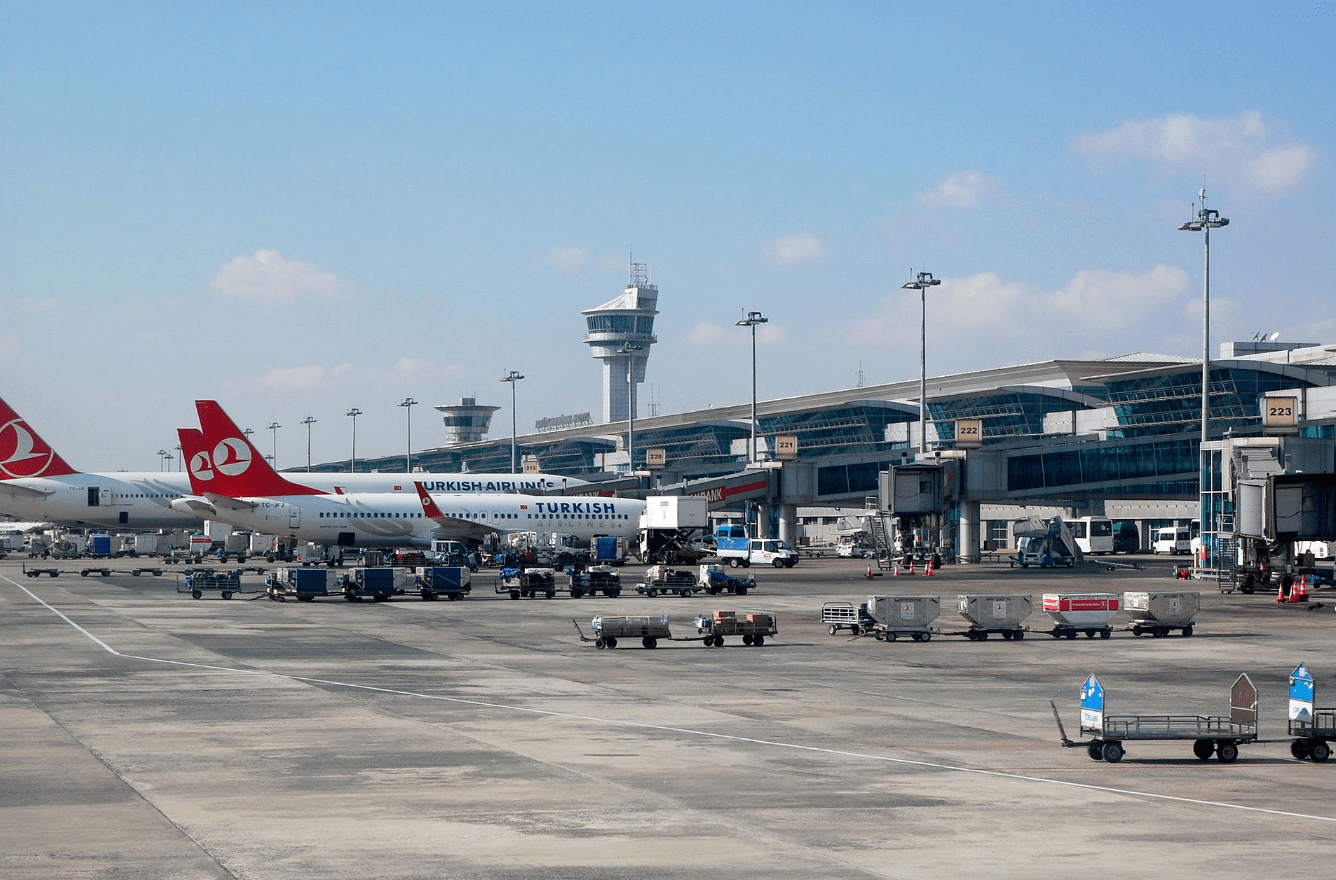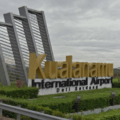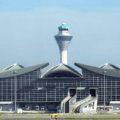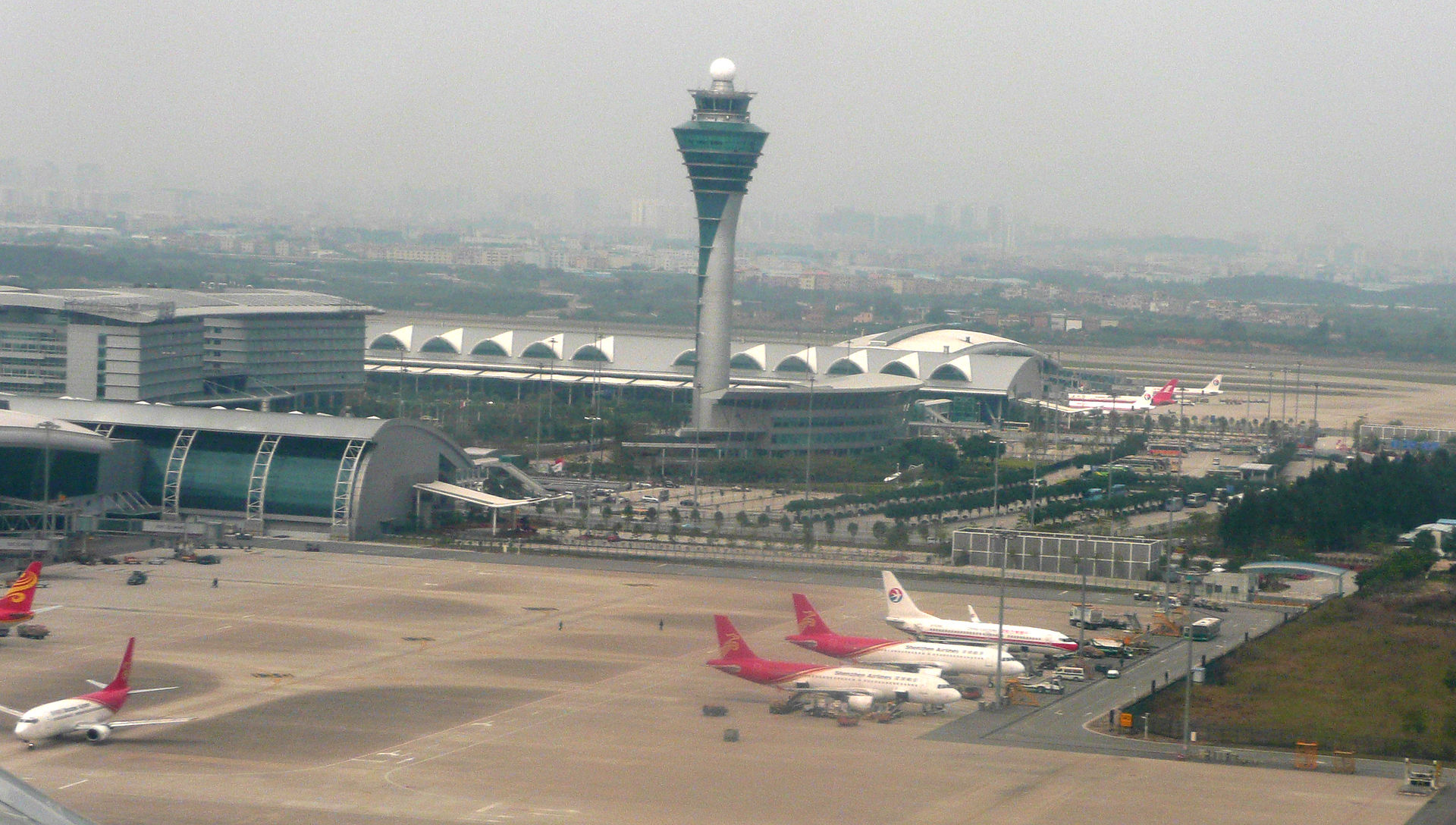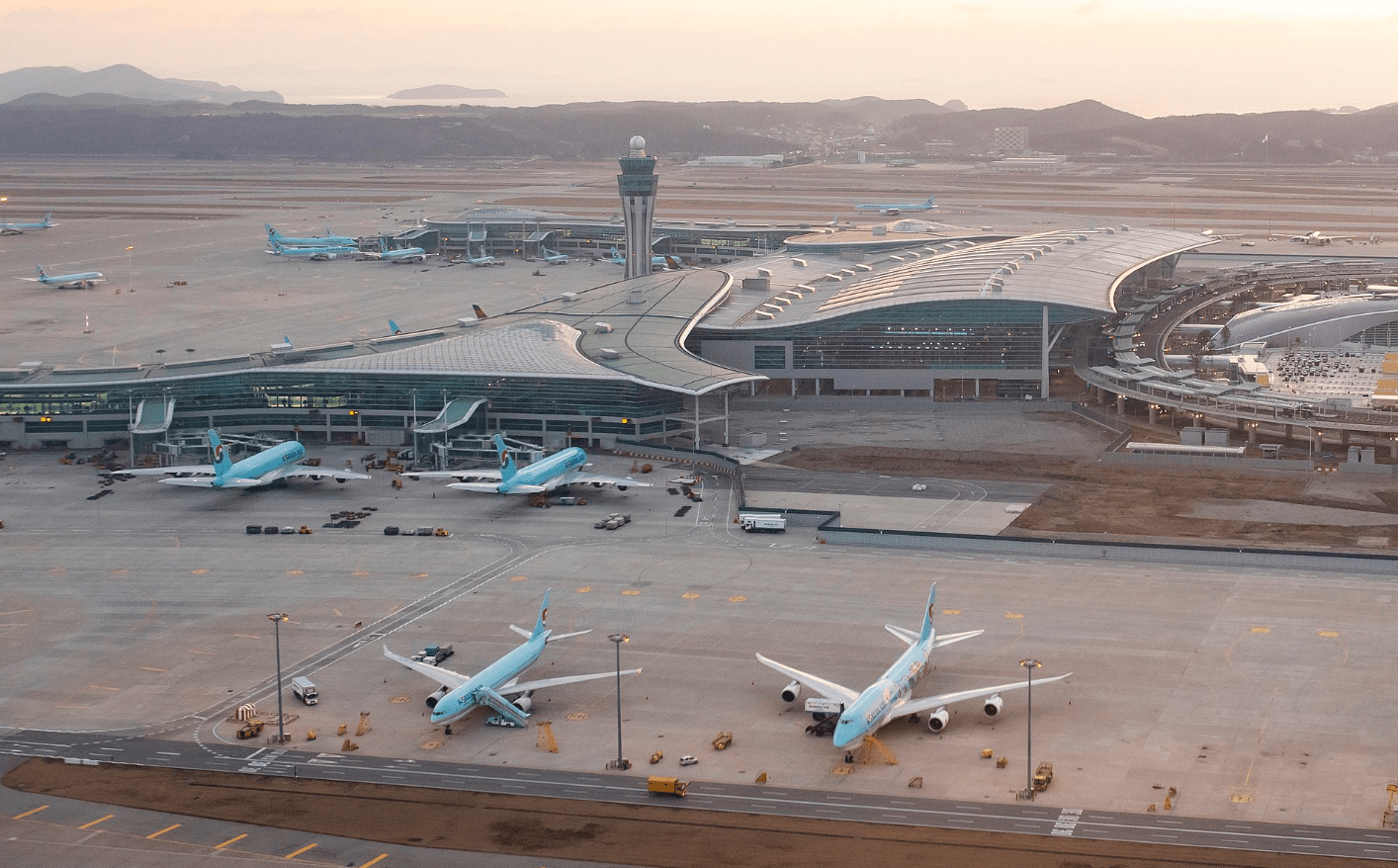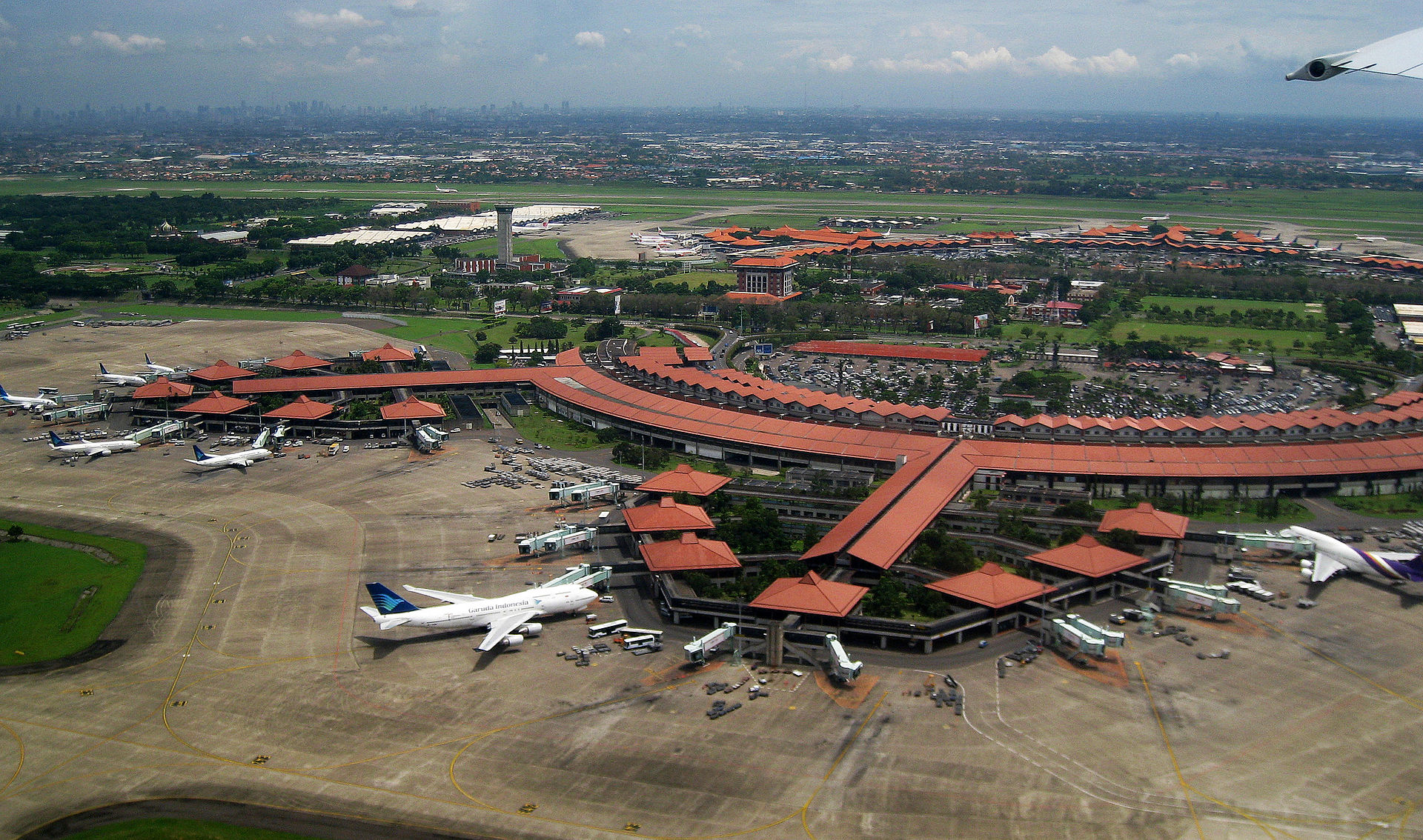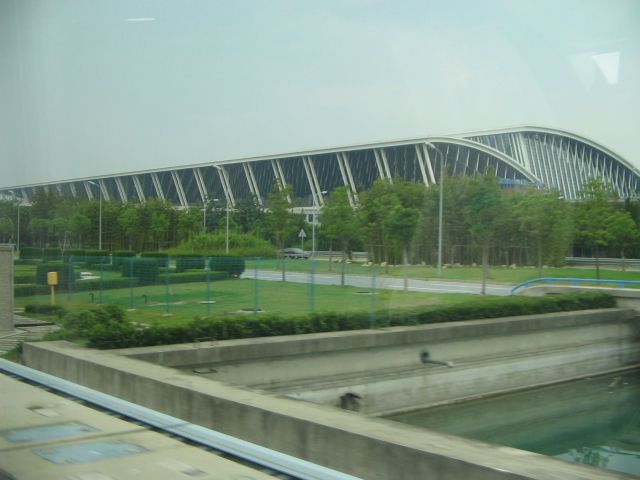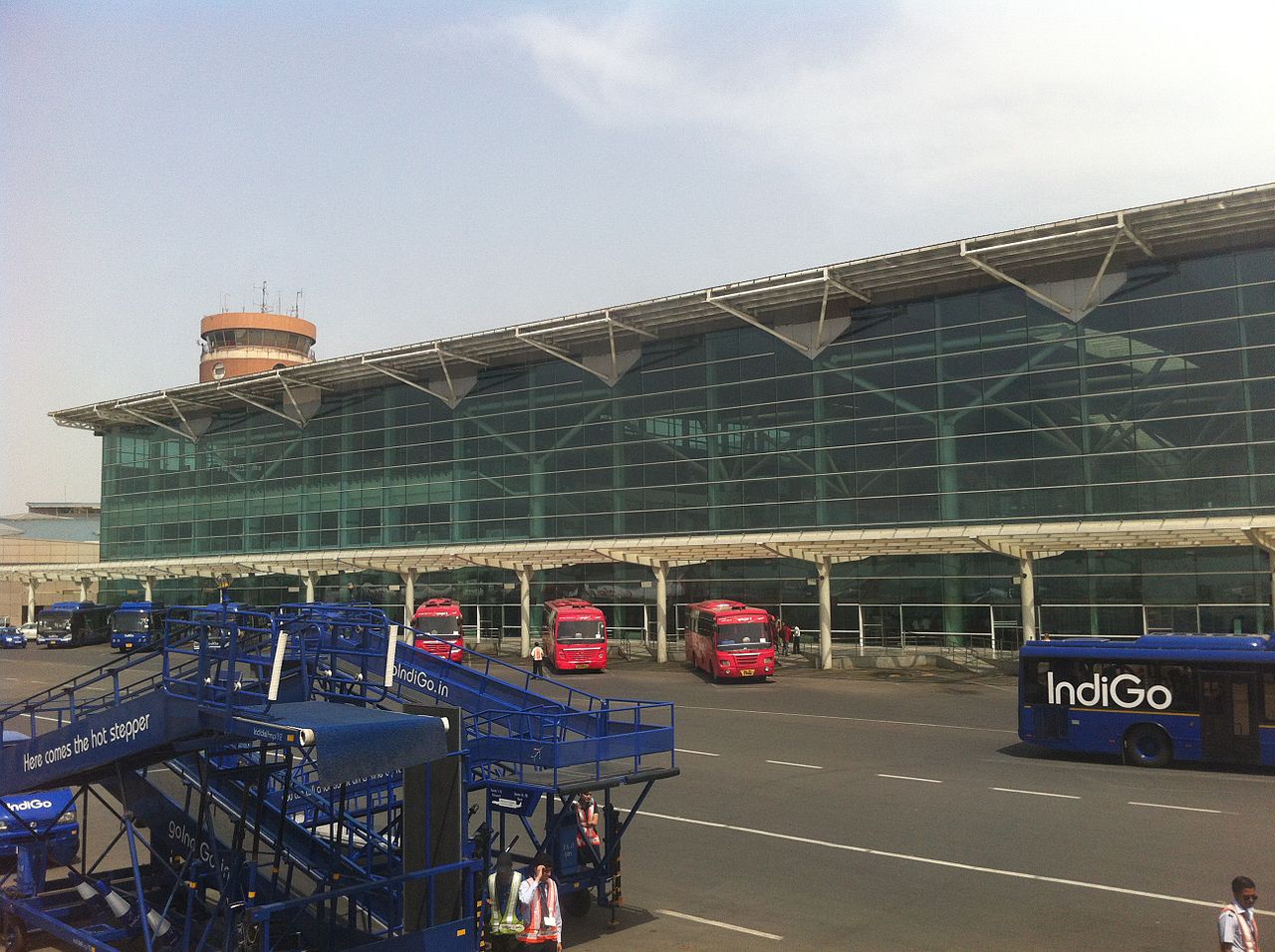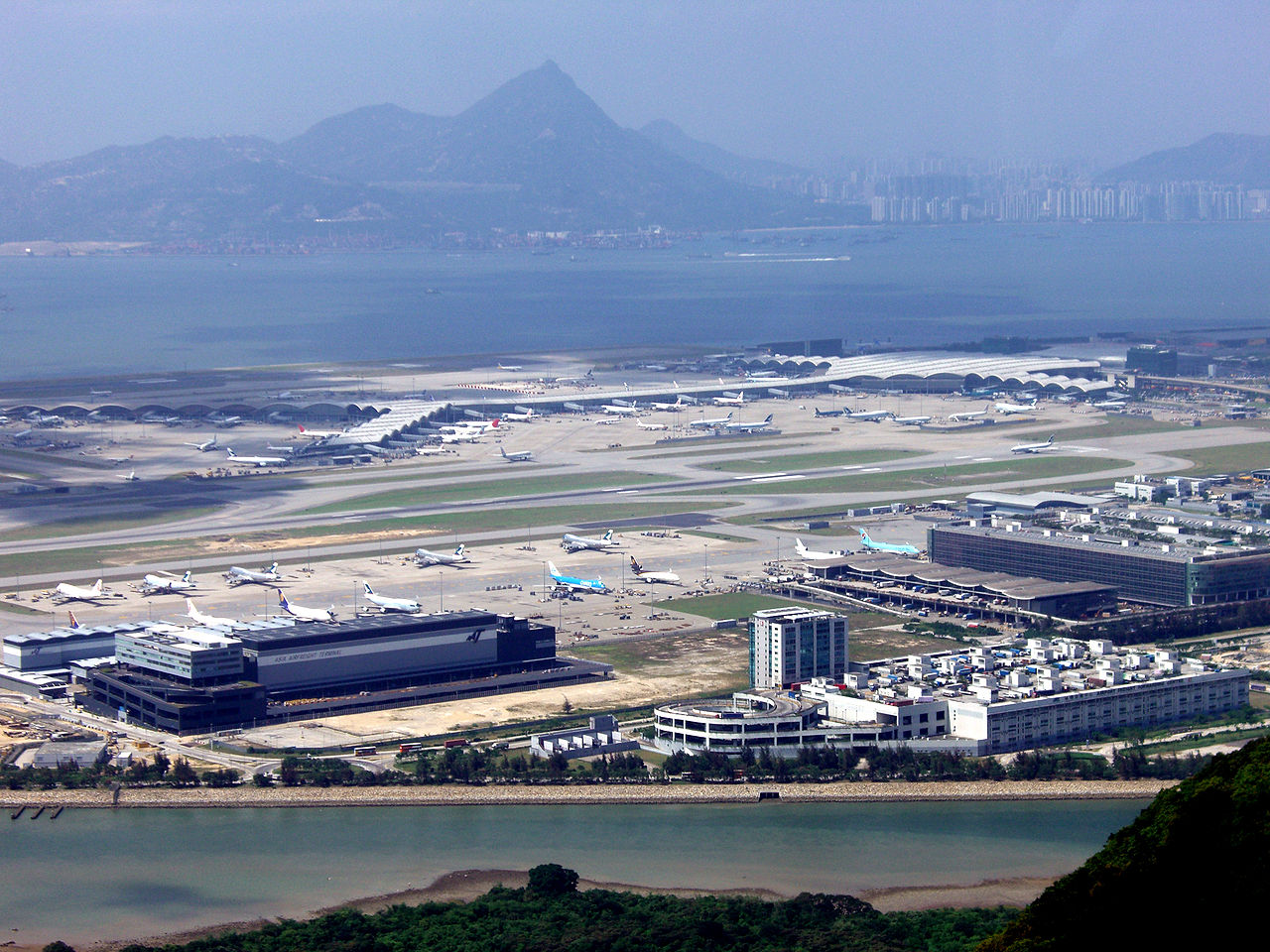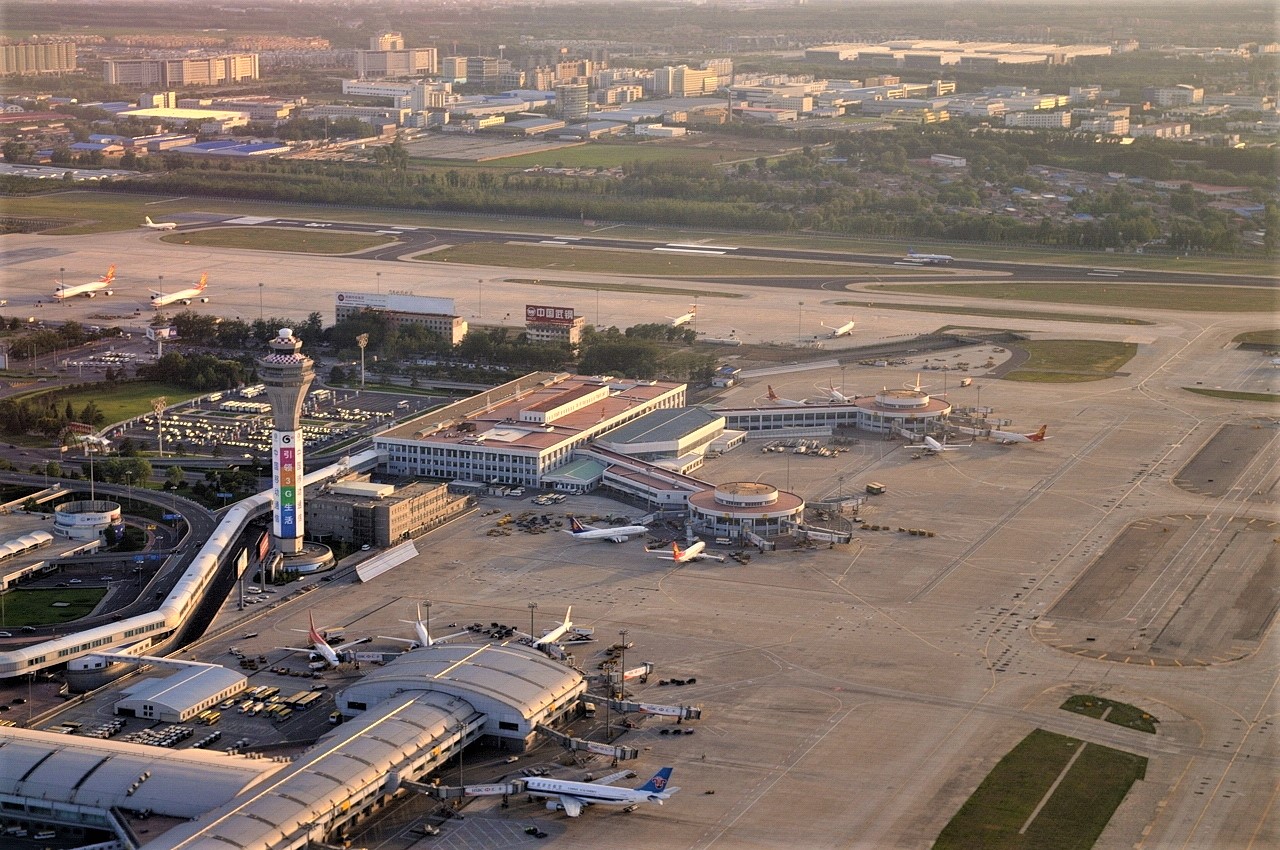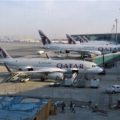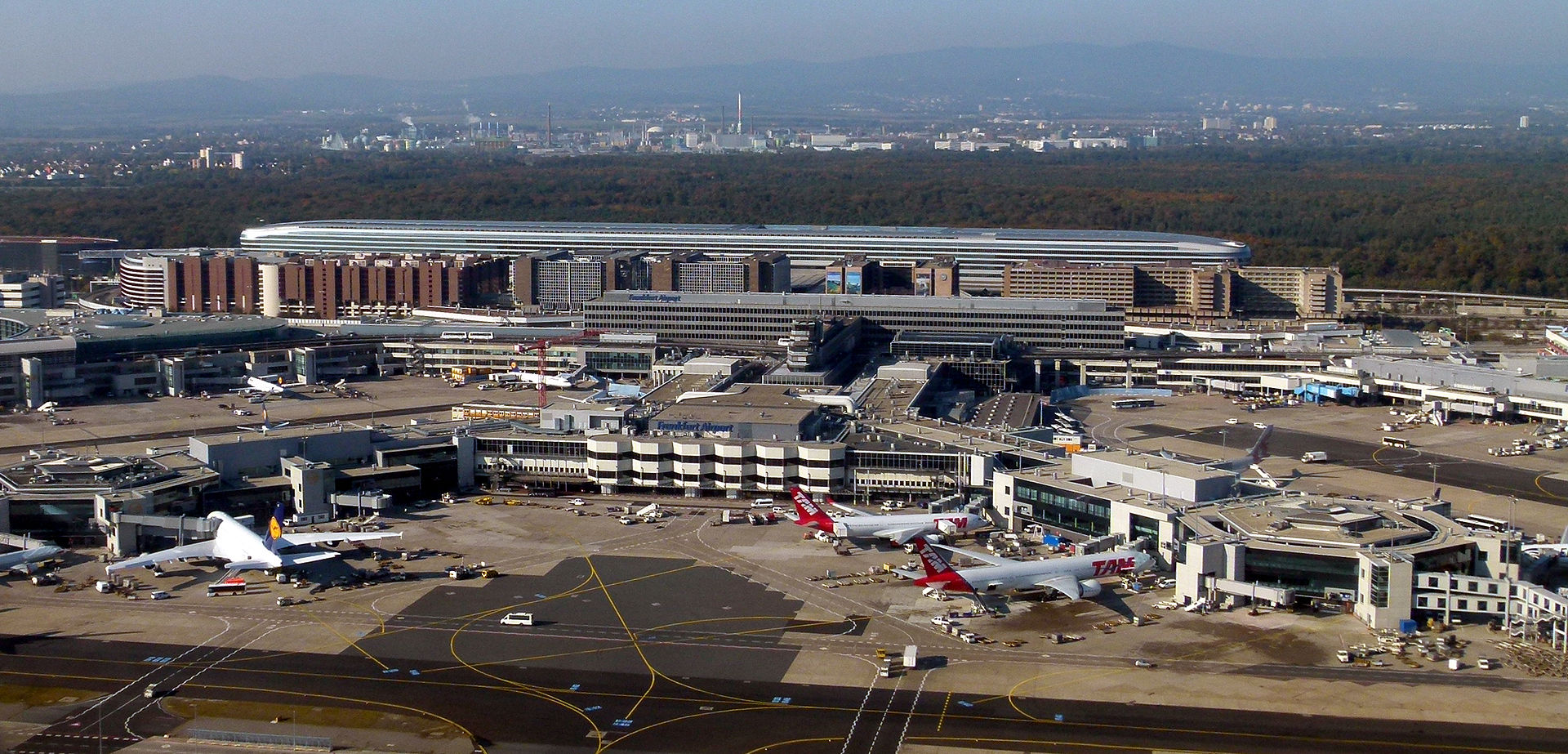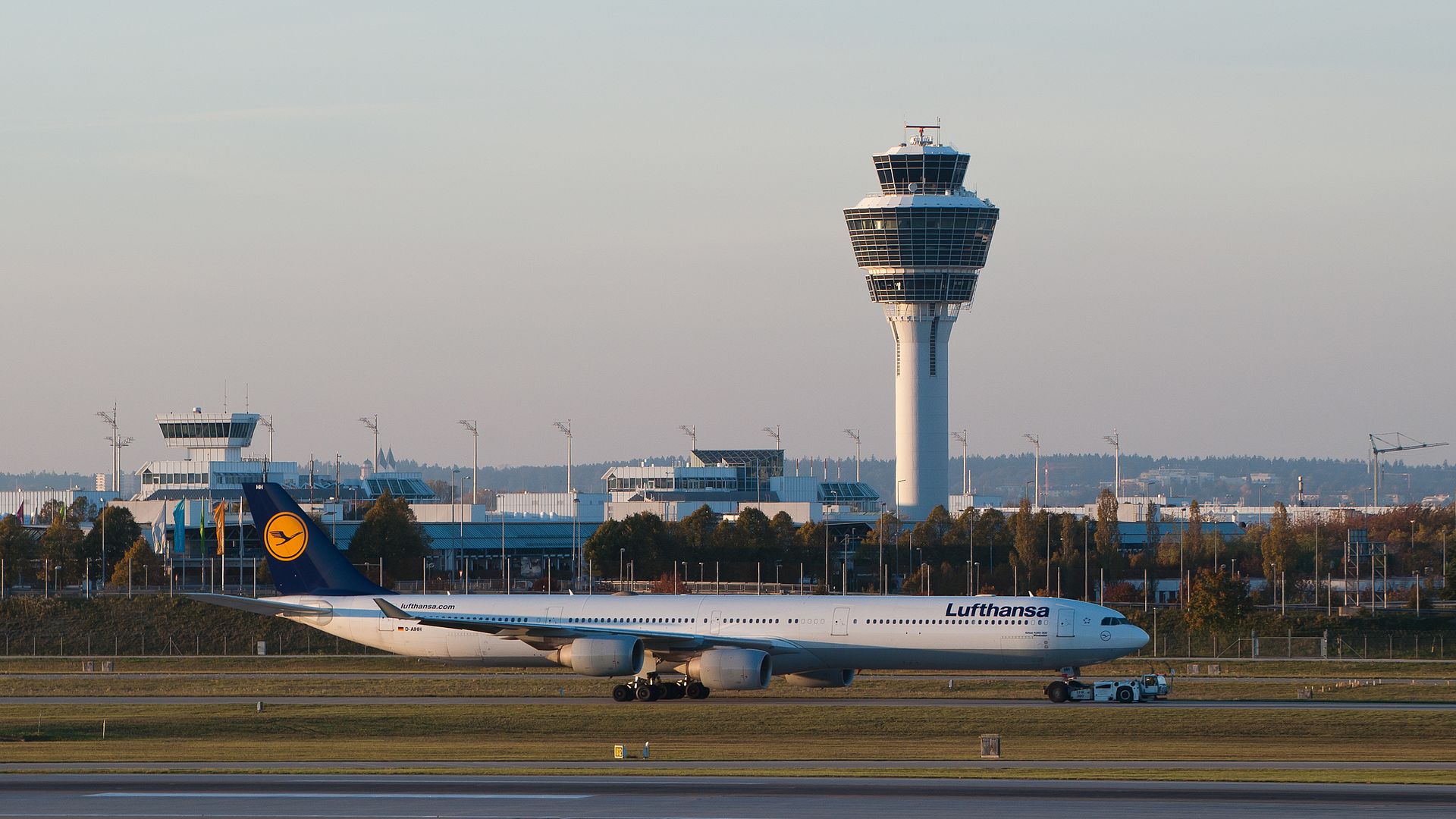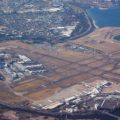Aviation
Singapore Changi Airport
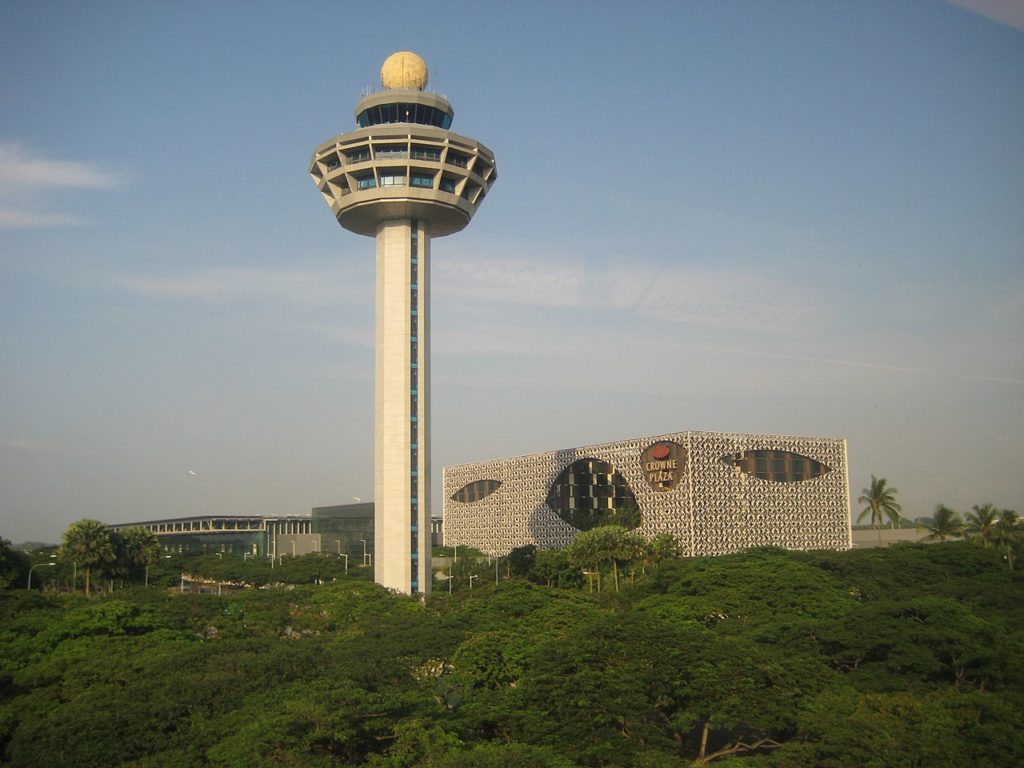
Source: Lars Curfs (Grashoofd)
| IATA: SIN ICAO: WSSS WMO: 48698 | |
| Airport type | Public / Military |
| Owner | Government of Singapore |
| Operator | Changi Airport Group (CAG) Civil Aviation Authority of Singapore (CAAS) Republic of Singapore Air Force (RSAF) |
| Serves | Singapore |
| Location | Changi, East Region, Singapore |
| Opened | 1 July 1981 (operational) 29 December 1981 (official) |
| Hub for | Jetstar Asia Airways Scoot SilkAir Singapore Airlines Singapore Airlines Cargo FedEx Express |
| Focus city for | All Nippon Airways, AirAsia , Qantas |
| Time zone | SST (UTC+08:00) |
| Elevation AMSL | 6.66 m / 22 ft |
| Coordinates | |
| Website | changiairport.com |
Singapore Changi Airport, commonly known as Changi Airport (IATA: SIN, ICAO: WSSS), is a major civilian airport that serves Singapore, and is one of the largest transportation hubs in Asia. It is currently rated the World’s Best Airport by Skytrax for the eighth consecutive year since 2013. It is also the first Airport in the world to do so for eight consecutive years and is one of the world’s busiest airports by international passenger and cargo traffic. The airport is located in Changi, at the eastern end of Singapore, approximately 20 km (12 mi) from Marina Bay (Singapore’s Downtown Core), on a 13-square-kilometre (5.0 sq mi) site. The airport is operated by Changi Airport Group and it is the home base of Singapore Airlines, Singapore Airlines Cargo, SilkAir, Scoot, Jetstar Asia Airways and BOC Aviation.
In 2019, Changi served 68.3 million passengers, making it the 17th busiest airport in the world.
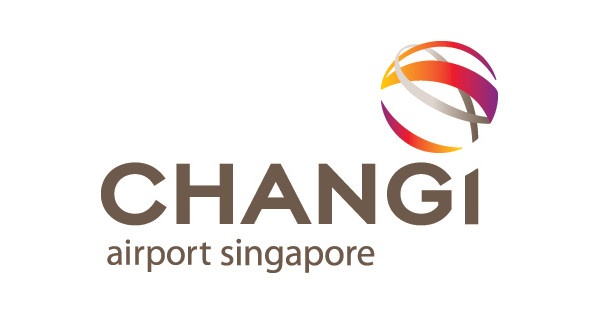

Overview
Changi Airport serves more than 100 airlines flying to 380 cities in around 100 countries and territories worldwide, as of 31 December 2019. About 7,400 flights arrive or depart at Changi each week – about one every 80 seconds.
For the 2019 full-year figures published by the airport, the airport handled 68,300,000 passengers (a 4.0% increase over the previous year), the most in its 38-year history. This made it the seventh busiest airport by international passenger traffic in the world and the third busiest in Asia. In December 2019, Changi Airport registered a total of 6.41 million passenger movements, the highest the airport has ever achieved in a month since it opened in 1981. Its daily traffic movement record was also broken on 20 December 2019, with 226,692 passengers passing through during that day. In addition to being an important passenger hub, the airport is also one of the busiest cargo airports in the world, handling 2.01 million tonnes of cargo in 2019. The total number of commercial aircraft movements decrease by 1.0% from the previous year to 382,000 in 2019.
The airport has won over 620 awards since its opening, including 28 “Best Airport” awards in 2019 alone. Changi Airport’s efforts to mitigate the effects of ageing infrastructure include continual physical upgrades to its existing terminals and building new facilities to maintain its high standards in airport service quality.
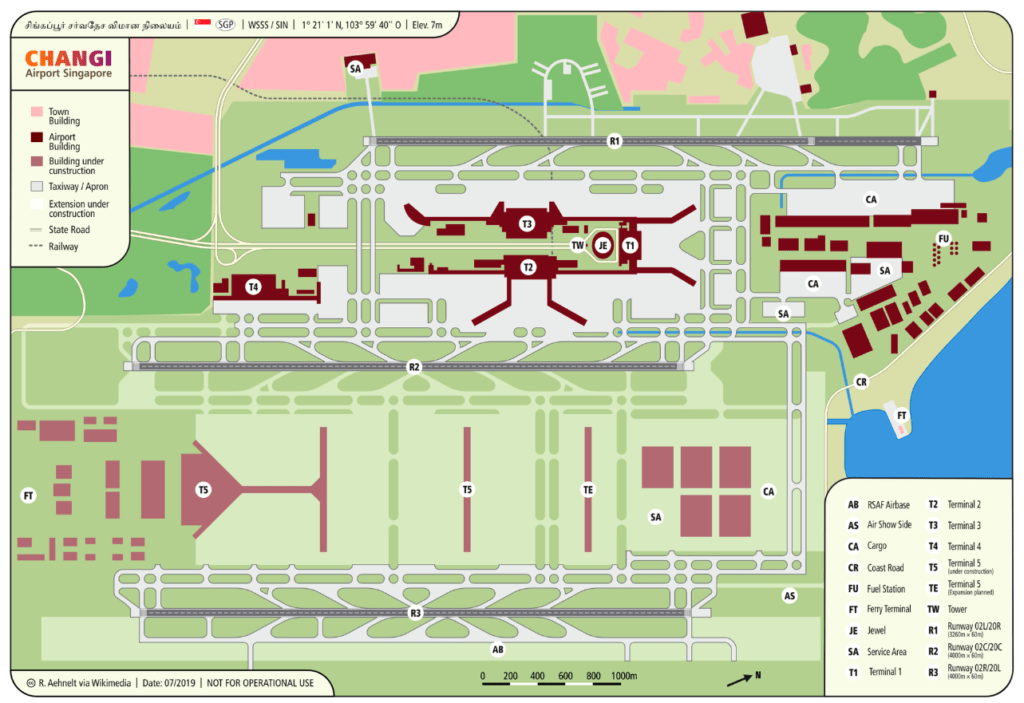

Source: CellarDoor85 (Robert Aehnelt)
Passenger terminals
Changi Airport has five main passenger terminals arranged in an elongated inverted ‘U’ shape with Jewel in the centre of the ‘U’ shape. Currently, the airport has a designed total annual handling capacity of 85 million passengers.
- Terminal 1, opened on 1 July 1981, is located at the northern end. This terminal was renovated in 2019.
- Terminal 2, opened on 22 November 1990, is located at the eastern end. (Operations suspended from 1 May 2020 for 18 months.)
- Terminal 3, opened on 9 January 2008, is located at the western end.
- Terminal 4, opened on 31 October 2017, is located on the southern side, at the site of the former budget terminal. (Operations suspended indefinitely from 16 May due to weak demand as a result of COVID-19 pandemic in Singapore)
There is also a privately run luxury terminal called the JetQuay CIP Terminal. It is similar to the Lufthansa First Class Terminal at Frankfurt Airport, but is open to all passengers travelling in all classes on all airlines with an access fee.
The short-lived Budget Terminal was opened on 26 March 2006 and closed on 25 September 2012 to make way for a larger Terminal 4.
Mixed-use development
Jewel Changi Airport, opened on 17 April 2019, is a multi-use structure, mainly a shopping mall, interconnecting Terminals 1, 2 and 3. Part of this project will help expand Terminal 1 to handle 24 million passengers per year.
Future terminals and projects
Terminal 5 is set to be ready in the mid 2030s. It is expected to handle 50 million passenger movements per annum.The airport terminal structure is projected to be larger than terminals 1, 2 and 3 combined. It will be built on reclaimed land to the east of the present terminals. It will be funded through the newly increased levy.KPF Singapore with Heatherwick Studio, Architects 61, and DP Architects will provide architectural services. Arup Singapore, Mott MacDonald Singapore and Surbana Jurong Consultants will provide engineering services.
Operations


Source:
Terence Ong


Source: I (David) created this work entirely by myself.
Passenger operations
As the airport only handles international passenger traffic, all terminals in operation are equipped with immigration-processing facilities for international travel.
After recovering from a drop in passenger traffic as a result of the September 11 attacks in 2001 and the severe acute respiratory syndrome (SARS) epidemic in 2003, the airport saw rapid growth in traffic, which hit the 30-million mark for the first time in 2004. In March 2008, prior to the full effect of the financial crisis of 2007–2010 on the global economy, the airport was predicted to handle 50 million passengers by 2012 due to the opening of casinos in Singapore and the phased liberalisation of the Asean aviation sector. As predicted, the airport surpassed the 50-million mark in 2012.
On 18 December 2017, the airport surpassed the 60-million mark for the first time
The airport saw a record 65.6 million passenger movements in 2018 – beating 2017’s record of 60 million passengers with a 5.5 per cent increase.
In 2019, Firefly, the sole turboprop operator in Changi Airport moved to Seletar Airport to make way for their jet operations.
In 2020, due to the ongoing COVID-19 pandemic, passenger traffic fell 32.8% due to the weakened demand for February. For the next few months, it is estimated that the numbers would further drop further. The pandemic also resulted in a 18 month closure of Terminal 2, starting from 1 May 2020, as the reduced passenger traffic deemed the terminal unnecessary. The previously planned expansion of Terminal 2 would therefore benefit from the closure, as a side effect, where it is believed that the 18 month closure would accelerate the expansion works by a year. Airlines previously utilising Terminal 2 would be reallocated to the remaining terminals.
Cargo
The Air Cargo Division of the Changi Airport Group (CAG) manages the Changi Airfreight Centre located in the north of the airport premises. The airport handled 1.81 million tonnes of air cargo in 2012, making it the 7th busiest airfreight hub in the world and the fifth busiest in Asia. Due to Singapore’s large electronics sector, electrical components constitute a significant part of the total cargo traffic handled at the airport. Changi airport has initiated attempts to expand into the perishable air cargo market. In 2015, Changi Airport handled 1,853,087 tonnes of air freight. Air Cargo World awarded the 2013 Air Cargo Excellence Award to Changi Airport for handling more than 1,000,000 tonnes of cargo in Asia.
The airport handled 2,006,300 tonnes of cargo in 2016, making it the 13th top cargo airport in the world and the sixth in the Asia Pacific region.
In 2017, the airport handled 2,125,226 tonnes of cargo. The top five cargo markets for the airport were China, Australia, Hong Kong, United States and India.
Key markets and destinations
In 2018, Indonesia was the largest market for the airport, followed by Malaysia, China, Thailand, Australia, India, Hong Kong, Japan, Philippines and Vietnam. Kuala Lumpur was the top destination for travellers in the airport, followed by Bangkok, Jakarta, Hong Kong, Manila, Denpasar/Bali, Tokyo, Ho Chi Minh City, Taipei and Sydney.
Safety and security


Source: Murgatroyd49
The Changi Airport Group (CAG) manages the overall safety and security of the airport. The Airport Management Division of the CAG manages the customer aspects of the airport’s security, while the Aviation Security Unit oversees the airport’s compliance with aviation security (AVSEC) policies, and manages AVSEC-related projects. The airport’s emergency and fire-fighting services are handled by the Airport Emergency Service Division. The Airport Emergency Services handles all instances of rescue and fire-fighting within the airport premises as well as in surrounding waters. It operates from two main fire stations (Station 1 by Runway 1 along West Perimeter Road and Station 2 by Runway 2 along Changi Coast Road), one sub-station (Domestic Fire Station), and one sea rescue base near the airport.
The airport’s security comes under the regulatory purview of the Airport Police Division of the Singapore Police Force (SPF). The day to day discharge of security functions at the airport is performed by auxiliary police forces including Aetos Security Management, Certis CISCO and SATS Security Services. Aetos and SATS Security Services are affiliated to the ground handling companies of Dnata and Singapore Changi Airport Terminal Services respectively. On 29 April 2008, CAAS signed its then-biggest single security contract for all airport-related security services by engaging Certis CISCO to provide security services at Singapore Changi Airport, as well as Seletar Airport, Changi Airfreight Centre, and the Singapore Air Traffic Control Centre. It involves the deployment of about 2,600 Certis Cisco personnel, including armed Auxiliary Police Officers and unarmed aviation security officers to perform tasks such as screening checked baggage, controlling access to restricted areas, and screening passengers before they board their aircraft.
Since the 11 September 2001 attacks and the naming of the airport as a terrorist target by the Jemaah Islamiyah, the airport’s security has been tightened. Singapore Armed Force and Singapore Police Force officers, armed with assault rifles or sub-machine guns, has been deployed to patrol the terminals at random intervals. Officers from the Gurkha Contingent are also dispatched to patrol the transit areas of the terminal buildings. These measures come at a cost partly borne by travellers in the form of a “passenger security service charge”, imposed since 2002.
In 2005, an upgrade in screening technology and rising security concerns led to luggage-screening processes being conducted behind closed doors, as opposed to them being done before check-in within public view. The screening of carry-on luggage and travellers are mostly conducted at individual departure gates, while check-in luggage is screened in the backrooms and secured before loading. A perimeter intrusion detection system for Changi Airport’s perimeter fence has also been put in place to further strengthen the security of the airfield, while a biometric access control system for staff movement has been put in place since 2006.
Airlines and destinations
Passenger
| Aeroflot | Moscow-Sheremetyevo (resumes 25 October 2020) |
| Air China | Beijing–Capital, Chengdu, Yinchuan |
| Air France | Paris–Charles de Gaulle |
| Air India | Chennai, Delhi, Mumbai |
| Air India Express | Bangalore Chennai, Coimbatore, Kochi, Madurai, Tiruchirappalli |
| Air Mauritius | Kuala Lumpur–International, Mauritius |
| Air New Zealand | Auckland Seasonal: Christchurch |
| Air Niugini | Port Moresby |
| Air Timor operated by Druk Air | Dili |
| AirAsia | Ipoh, Kota Kinabalu, Kuala Lumpur–International, Kuching, Langkawi, Miri, Penang |
| AirAsia X | Kuala Lumpur–International |
| All Nippon Airways | Tokyo–Haneda, Tokyo–Narita |
| Asiana Airlines | Seoul–Incheon |
| Bangkok Airways | Bangkok–Suvarnabhumi, Koh Samui |
| Batik Air | Jakarta–Soekarno-Hatta |
| Biman Bangladesh Airlines | Dhaka |
| British Airways | London–Heathrow, Sydney |
| Cathay Pacific | Bangkok–Suvarnabhumi, Hong Kong |
| Cebu Pacific | Cebu, Clark, Davao, Iloilo, Manila (suspended) |
| Citilink | Jakarta–Soekarno-Hatta |
| China Airlines | Kaohsiung, Taipei–Taoyuan |
| China Eastern Airlines | Changchun, Changsha, Hangzhou, Kunming, Quanzhou, Shanghai–Pudong |
| China Southern Airlines | Guangzhou, Hohhot |
| Chongqing Airlines | Chongqing |
| Druk Air | Bangkok–Suvarnabhumi, Guwahati, Paro |
| Emirates | Dubai–International, Melbourne |
| Ethiopian Airlines | Addis Ababa, Jakarta–Soekarno-Hatta, Kuala Lumpur–International |
| Etihad Airways | Abu Dhabi |
| EVA Air | Taipei–Taoyuan |
| Fiji Airways | Nadi |
| Finnair | Helsinki |
| Garuda Indonesia | Denpasar/Bali, Jakarta–Soekarno-Hatta, Surabaya |
| GoAir | Bangalore, Kolkata |
| GX Airlines | Lanzhou, Nanning |
| Hainan Airlines | Haikou |
| Hebei Airlines | Hangzhou |
| IndiGo | Bangalore, Chennai, Delhi, Hyderabad, Kolkata, Mumbai, Tiruchirappalli |
| Indonesia AirAsia | Bandung, Denpasar/Bali, Jakarta–Soekarno-Hatta, Semarang, Yogyakarta–International |
| Japan Airlines | Tokyo–Haneda, Tokyo–Narita |
| Jetstar Airways | Denpasar/Bali, Perth |
| Jetstar Asia Airways | Bangkok–Suvarnabhumi, Clark, Colombo–Bandaranaike (begins 1 July 2020), Da Nang, Darwin, Denpasar/Bali, Haikou, Ho Chi Minh City, Jakarta–Soekarno-Hatta, Jieyang, Kuala Lumpur–International, Manila, Medan, Naha, Osaka–Kansai, Penang, Phnom Penh, Phuket, Sanya, Siem Reap, Surabaya, Taipei–Taoyuan, Yangon |
| Jetstar Pacific Airlines | Ho Chi Minh City |
| Jeju Air | Busan |
| Juneyao Airlines | Shanghai–Pudong |
| KLM | Amsterdam, Denpasar/Bali |
| Korean Air | Seoul–Incheon |
| Lion Air | Jakarta–Soekarno-Hatta |
| LOT Polish Airlines | Warsaw–Chopin |
| Lufthansa | Frankfurt, Munich |
| Malaysia Airlines | Kuala Lumpur–International, Kuching |
| Malindo Air | Kuala Lumpur–International |
| Myanmar Airways International | Yangon |
| Myanmar National Airlines | Yangon |
| Philippine Airlines | Manila (suspended) |
| Philippines AirAsia | Cebu |
| Qantas | Brisbane, London–Heathrow, Melbourne, Perth, Sydney |
| Qatar Airways | Doha |
| Regent Airways | Dhaka |
| Royal Brunei Airlines | Bandar Seri Begawan |
| Saudia | Jeddah |
| Scoot | Amritsar, Athens, Balikpapan (begins 30 June 2020), Bangkok–Don Mueang, Bangkok–Suvarnabhumi, Berlin–Tegel, Cebu, Changsha, Chennai (ends 24 May 2020), Chiang Mai, Clark, Coimbatore, Denpasar/Bali, Fuzhou, Gold Coast, Guangzhou, Haikou, Hangzhou, Hanoi, Harbin, Hat Yai, Ho Chi Minh City, Hong Kong, Hyderabad, Ipoh, Jakarta–Soekarno-Hatta, Jeddah, Jinan, Kaohsiung, Kota Bharu, Kota Kinabalu, Krabi, Kuala Lumpur–International, Kuantan, Kuching, Kunming, Langkawi, Luang Prabang, Macau, Makassar (begins 16 June 2020), Manado (begins 1 June 2020), Manila (suspended), Mataram–Lombok (begins 14 July 2020), Melbourne, Nanchang, Nanjing, Nanning, Ningbo, Osaka–Kansai, Palembang, Pekanbaru, Penang, Perth, Phuket, Qingdao, Sapporo–Chitose, Semarang (begins 2 June 2020), Seoul–Incheon, Shenyang, Surabaya, Sydney, Taipei–Taoyuan, Thiruvananthapuram, Tianjin, Tiruchirappalli, Tokyo–Narita, Vientiane, Visakhapatnam, Wuhan, Wuxi, Xi’an, Yogyakarta–International (begins 20 May 2020), Zhengzhou |
| Shenzhen Airlines | Shenzhen |
| Sichuan Airlines | Chengdu |
| SilkAir | Balikpapan (ends 29 June 2020), Bandung, Bangalore, Cairns, Cebu, Chengdu, Chennai, Chongqing, Colombo–Bandaranaike, Da Nang, Darwin, Davao, Denpasar/Bali, Hanoi, Hyderabad, Kathmandu, Kochi, Koh Samui, Kuala Lumpur–International, Makassar (ends 15 June 2020), Malé, Manado (ends 31 May 2020), Mataram–Lombok (ends 13 July 2020), Medan, Penang, Phnom Penh, Phuket, Semarang (ends 1 June 2020), Shenzhen, Siem Reap, Surabaya, Xiamen, Yangon, Yogyakarta–International (ends 19 May 2020) Seasonal: Mandalay |
| Singapore Airlines | Adelaide, Ahmedabad, Amsterdam, Auckland, Bandar Seri Begawan, Bangalore, Bangkok–Suvarnabhumi, Barcelona, Beijing–Capital, Brisbane, Brussels (resumes 25 October 2020), Busan, Canberra, Cape Town, Chennai, Christchurch, Colombo–Bandaranaike, Copenhagen, Delhi, Denpasar/Bali, Dhaka, Dubai–International, Düsseldorf, Frankfurt, Fukuoka, Guangzhou, Hanoi, Ho Chi Minh City, Hong Kong, Houston–Intercontinental, Istanbul, Jakarta–Soekarno-Hatta, Johannesburg–O.R. Tambo, Kolkata, Kuala Lumpur–International, London–Heathrow, Los Angeles, Malé, Manchester, Manila (suspended),[89] Melbourne, Milan–Malpensa, Moscow–Domodedovo, Mumbai, Munich, Nagoya–Centrair, Newark, New York–JFK, Osaka–Kansai, Paris–Charles de Gaulle, Perth, Phuket, Rome–Fiumicino, San Francisco, Seattle/Tacoma, Seoul–Incheon, Shanghai–Pudong, Stockholm–Arlanda, Surabaya, Sydney, Taipei–Taoyuan, Tokyo–Haneda, Tokyo–Narita, Wellington, Yangon, Zürich Seasonal: Sapporo–Chitose |
| Spring Airlines | Shanghai–Pudong |
| SriLankan Airlines | Colombo–Bandaranaike |
| Swiss International Air Lines | Zürich |
| Thai AirAsia | Bangkok–Don Mueang, Krabi, Phuket |
| Thai Airways | Bangkok–Suvarnabhumi |
| Thai Lion Air | Bangkok–Don Mueang |
| Turkish Airlines | Istanbul |
| United Airlines | San Francisco (resumes 6 July 2020) |
| Urumqi Air | Urumqi, Wuhan |
| US-Bangla Airlines | Dhaka |
| VietJet Air | Da Nang, Hanoi, Ho Chi Minh City |
| Vietnam Airlines | Hanoi, Ho Chi Minh City |
| Vistara | Delhi, Mumbai |
| XiamenAir | Dalian, Fuzhou, Xiamen |
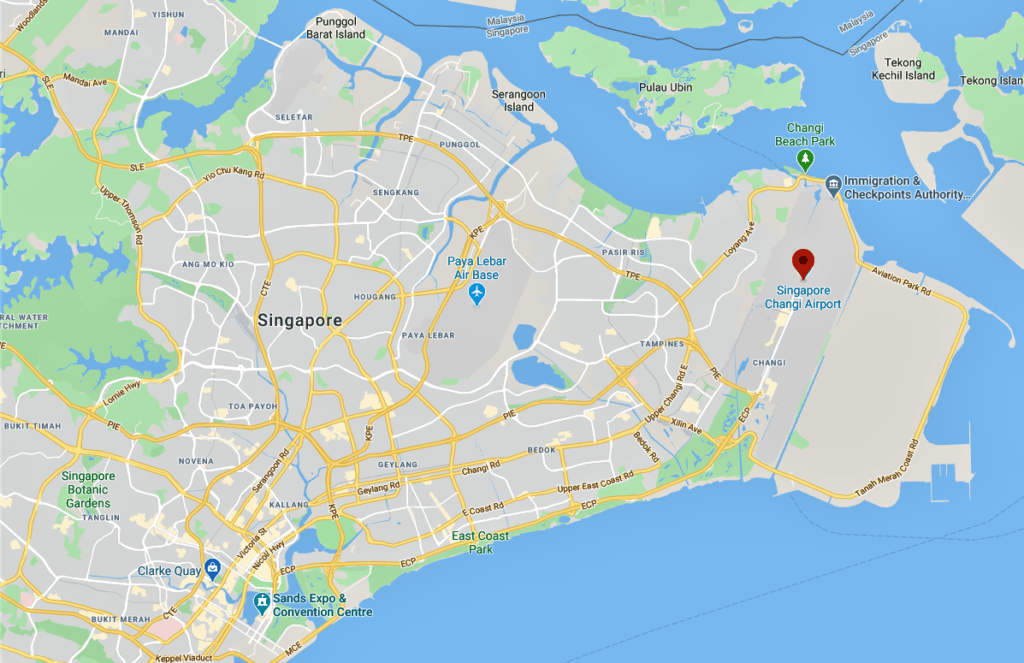

Cargo
| AirBridgeCargo | Hong Kong, Moscow–Sheremetyevo, Phnom Penh |
| Air Hong Kong | Hong Kong |
| ANA Cargo | Hong Kong, Naha |
| Asiana Cargo | Seoul–Incheon |
| Asialink Cargo Express | Batam |
| ASL Airlines Belgium | Liège, Shanghai–Pudong |
| Cardig Air | Balikpapan, Jakarta–Soekarno–Hatta |
| Cargolux | Anchorage, Baku, Chicago–O’Hare, Doha, Ho Chi Minh City, Hong Kong, Kuala Lumpur–International, Luxembourg |
| Cathay Pacific Cargo | Bangkok–Suvarnabhumi, Hanoi, Hong Kong, Penang |
| China Airlines Cargo | Bangkok–Suvarnabhumi, Manila, Penang, Taipei–Taoyuan |
| China Cargo Airlines | Bangkok–Suvarnabhumi, Chengdu, Shanghai–Pudong |
| DHL Aviation | Anchorage, Bangalore, Cincinnati, Hong Kong, Leipzig/Halle, Seoul–Incheon |
| Emirates SkyCargo | Dubai–Al Maktoum, Melbourne, Sydney |
| Etihad Cargo | Abu Dhabi, Brisbane, Sydney |
| EVA Air Cargo | Bangkok–Suvarnabhumi, Hanoi, Hong Kong, Penang, Taipei–Taoyuan |
| FedEx Express | Anchorage, Guangzhou, Ho Chi Minh City, Jakarta–Soekarno–Hatta, Memphis, Osaka–Kansai, Penang, Shanghai–Pudong, Sydney, Taipei–Taoyuan, Tokyo–Narita |
| Hong Kong Airlines | Hong Kong |
| K-Mile Air | Bangkok–Suvarnabhumi, Jakarta–Soekarno–Hatta |
| Korean Air Cargo | Hanoi, Penang, Seoul–Incheon |
| My Indo Airlines | Balikpapan, Jakarta–Halim Perdanakusuma, Surabaya |
| Neptune Air | Kuala Lumpur–International |
| Nippon Cargo Airlines | Bangkok–Suvarnabhumi, Osaka–Kansai, Tokyo–Narita |
| Raya Airways | Kuala Lumpur–Subang |
| SF Airlines | Shenzhen |
| Silk Way West Airlines | Baku, Dubai–Al Maktoum, Kuala Lumpur–International |
| Singapore Airlines Cargo | Adelaide, Amsterdam, Auckland, Bengaluru, Bangkok–Suvarnabhumi, Brussels, Chennai, Coimbatore, Chicago–O’Hare, Copenhagen, Dallas/Fort Worth, Hanoi, Hong Kong, Jakarta–Soekarno–Hatta, Johannesburg–OR Tambo, London–Heathrow, Los Angeles, Medan, Melbourne, Mumbai, Nairobi–Jomo Kenyatta, Nanjing, Sharjah, Sydney |
| Tri-MG Intra Asia Airlines | Balikpapan, Batam, Jakarta–Soekarno–Hatta |
| Turkish Airlines Cargo | Hyderabad, Istanbul–Atatürk, Karachi |
| UPS Airlines | Hong Kong, Shenzhen, Sydney, Taipei–Taoyuan |
Accidents and incidents
- On 26 March 1991, Singapore Airlines Flight 117, operated by an Airbus A310, was hijacked by four Pakistani terrorists. The flight landed in Changi Airport at 22:15. The Singapore Special Operations Force stormed the plane, on the morning of 27 March. All four hijackers were killed, with no fatalities among the 123 passengers and crew that were held hostage for more than eight hours.
- On 4 November 2010, Qantas Flight 32, operated by an Airbus A380-800, suffered an uncontained engine failure and made an emergency landing in Changi Airport. Upon landing, one of the engines could not be shut down due to ruptured control cables and had to be doused for three hours by airport firefighters to forcefully shut it down. There were no crew or passenger injuries, and all 469 people on board survived this incident.
- On 27 June 2016, Singapore Airlines Flight 368, operated by a Boeing 777-300ER, suffered an engine problem while flying from Singapore to Milan. During the diversionary landing in Singapore, the right engine and wing caught fire. The fire was quickly extinguished by airport fire services. There were no injuries among the 241 people on board.
- On 16 May 2017, a fire broke out at the departure hall in Terminal 2. The fire caused 40 flights at Terminal 2 to be delayed and diverted to Terminal 3. Terminal 2 was closed from 17:30 to 22:45.
- On 6 February 2018, a KAI T-50 Golden Eagle, part of the Black Eagles aerobatic team taking part in Singapore Airshow 2018, veered off the runway during takeoff and crashed. The resulting fire was put out by emergency services and the pilot was treated for minor injuries. Runway 1 was closed as a result and caused delays at the airport.
- On 19 June 2019, unauthorised drones were spotted around Changi Airport, causing 37 flights to be delayed and a runway to be shut intermittently. Another such incident took place on 24 June 2019, causing 18 flights to be delayed and 7 more diverted. The disruption was made worse by bad weather.
Ground transportation
Changi Airport was built with ground-transportation considerations in mind from the onset, with the East Coast Parkway built and opened in tandem with the airport, providing a direct link to the city centre. At a distance of about 20 km (12 mi), the expressway was built almost entirely on reclaimed land, thus minimising disruptions to the existing road network in Singapore’s East Coast.
Despite the four main passenger terminal buildings being relatively close to each other, the CAAS (Civil Aviation Authority of Singapore) decided to build the Changi Airport Skytrain people-mover system to facilitate quicker and more convenient transfers between the terminals for travellers. The system was upgraded in 2007 with new technologies supplied by Mitsubishi, connecting to Terminal 3 and separating checked-in passengers from the general public on distinct tracks.
Inter-terminal transportation


Source: Terence Ong


Source: HagenPapa2014
Terminals 1, 2 and 3 are connected by the free Skytrain service, which operates from 05:00 to 02:30. During non-operational hours, travellers in the transit areas may transfer within the terminals by foot via the inter-terminal travellators. For travellers in the public areas, a free shuttle bus service will connect the three terminals.
All Skytrain services have been suspended from 1 May 2020 until further notice.
A complimentary 24-hour Airport Shuttle Bus service plies between Terminal 3 and Terminal 4 in both the public and transit areas. The journey takes approximately eight to 10 minutes.
External connections
Mass Rapid Transit
The airport is connected to the Mass Rapid Transit (MRT) network via a two-stop branch of the East West line from Tanah Merah MRT station, consisting of two stations: Expo, serving the nearby Singapore Expo site; and Changi Airport. Changi Airport MRT station is located underground between Terminal 2 and Terminal 3. Direct, one-train service to the downtown and western parts of Singapore was initially in operation when the station opened on 8 February 2002. This was replaced by the current shuttle service between Tanah Merah and Changi Airport via Expo on 22 July 2003, when it was found that passenger demand for this route was low.
Until Stage 3 of the Downtown line opened on 21 October 2017, passengers needed to transfer at Tanah Merah station for train service towards the city, Pasir Ris and Tuas Link. However, as of this date, passengers can now transfer at Expo for direct service to Bukit Timah and Bukit Panjang using an alternate route via the city.
As announced in the LTA’s Land Transport Masterplan 2040, the new Thomson–East Coast line will be extended to Changi Airport Terminal 5 and to the current Changi Airport station, with the current EWL Branch line being converted to be part of the TEL.
Bus
There are seven bus services operated by SBS Transit, SMRT Buses and Go-Ahead Singapore, making a loop starting from Terminal 3 to Terminal 1, and Terminal 2. Only four bus services will continue to Terminal 4 – Services 24, 34, 36 and 110. Bus stops are located at the basement bus bays of Terminals 1, 2 and 3. For Terminal 4, the bus stop is located next to Car Park 4B.
Coaches to and from Johor Bahru are also available. Operated by Transtar Travel, the service will start at coach stands at Terminals 1, 2, 3 and end at Larkin Terminal.
There is also a free shuttle bus service plying between Changi Airport (T3) and Changi Business Park. This service is a 9-stop route, running from Mondays to Fridays, except public holidays.
Taxi
Taxis are available at taxi stands located in the arrival halls of each terminal. Limousine services are also available. There is an additional airport surcharge for all trips originating from the airport.
Private transport
All pick-ups by private transportation occur at the arrival pick-up points of each terminal.
Source: wikipedia
